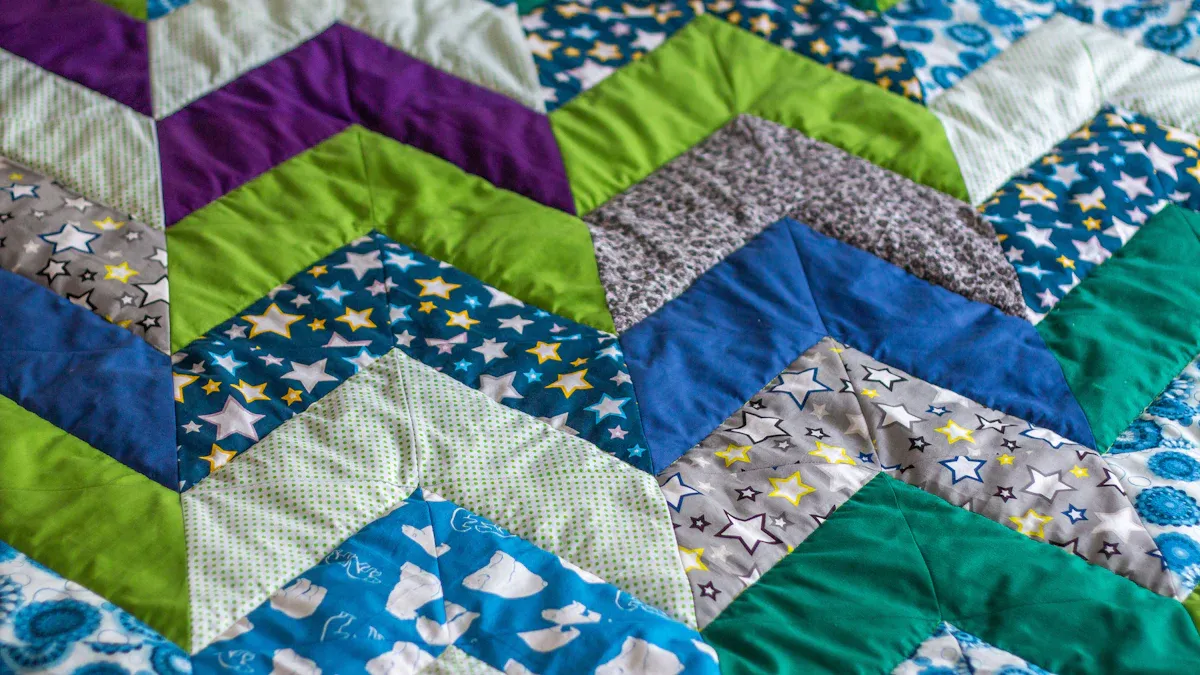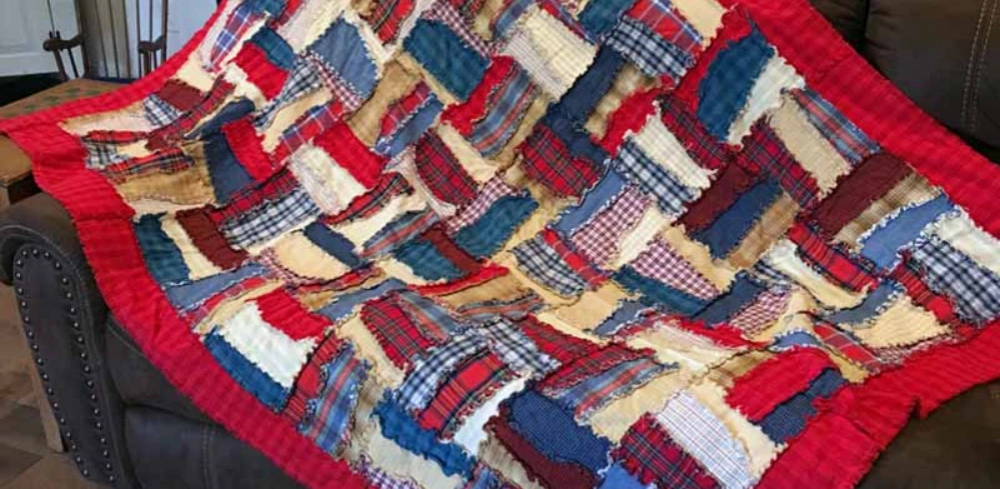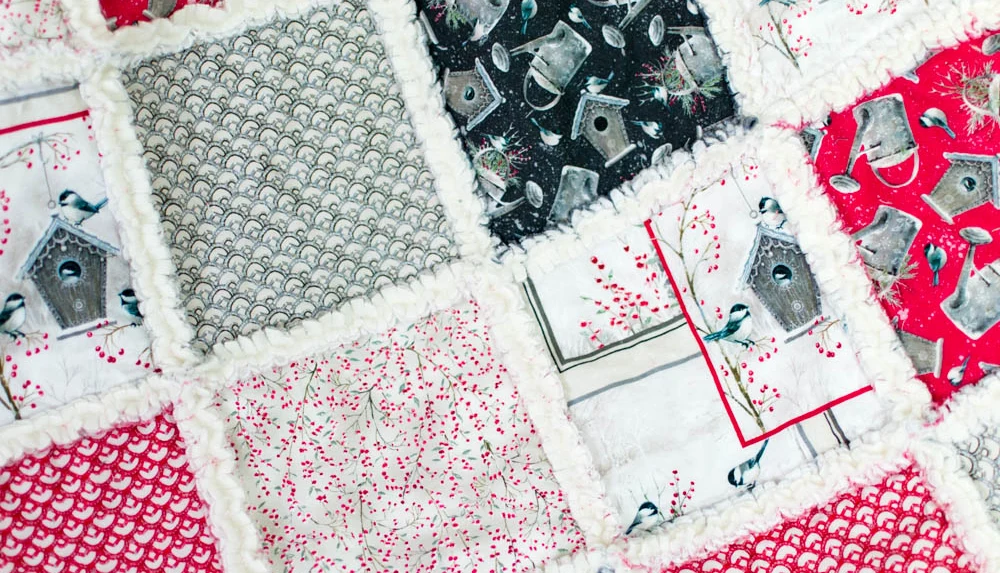
If you want the best fabric for rag quilt projects, reach for 100% cotton or flannel. These materials fray just right and give rag quilts their signature soft, cozy look.
The right cotton or flannel fabric makes a big difference in texture, durability, and how easy your quilt is to create. You’ll find a huge selection of flannel, cotton, and flannel fabric at Fanda Fabrics—perfect for making your next rag quilt a success.
Key Takeaways
Choose 100% cotton or flannel for the best rag quilt fabric because they fray well and feel soft.
Always prewash your fabrics to prevent shrinkage and color bleeding, keeping your quilt looking great.
Mix fabrics with similar weights, like cotton, flannel, or denim, to add texture without uneven shrinking.
Cut, sew, and clip seams carefully to create fluffy, ragged edges that get softer with washing.
Use high-quality fabrics from trusted sources like Fanda Fabrics for durable, cozy quilts that last.
Best Fabric for Rag Quilt

When you start a rag quilt, the fabric you choose makes all the difference. The best fabric for rag quilt projects will fray just right, feel soft, and last through many washes. Let’s look at the top choices and what you should avoid.
Cotton
If you want a classic rag quilt that stands the test of time, 100% cotton is your best friend. Quilting cotton has a plain weave that gives you stability and keeps your blocks from stretching or distorting. You’ll find that high-quality cotton, like the Cotton Quilting Fabric and Solids Cotton Fabric from Fanda Fabrics, offers:
A smooth, strong surface that holds up to repeated washing.
Minimal shrinkage, especially if you pre-wash.
A structure that helps your quilt blocks stay crisp and neat.
Less lint and pilling, thanks to long-staple fibers.
Quilting cotton is easy to cut, sew, and handle. It frays just enough to give you that signature ragged edge without falling apart. Many quilters agree that the best fabric for rag quilt projects is always a high-quality cotton from a trusted source, like the Quilting Collection at Fanda Fabrics.
Flannel
Flannel is another top pick for rag quilts, especially if you love a cozy, fuzzy finish. Flannel fabric frays more than regular cotton, which is exactly what you want for those fluffy seams. Here’s why flannel stands out:
Soft, fuzzy texture that feels warm and inviting.
Frays easily, creating the perfect ragged look after washing.
Yarn-dyed flannel rags are even better, giving you a beautiful effect.
Flannel shrinks more than cotton, so pre-washing is a must.
You might use flannel for the whole quilt or just the backing. Either way, you’ll get a flannel quilt that feels extra snuggly. Fanda Fabrics offers a wide range of flannel fabric options, so you can mix and match colors and patterns for a unique design.
Tip: Wait until your quilt is finished before washing to get the best frayed edges. Protect small flannel pieces during washing to avoid too much fraying.
Denim and Others
Some quilters like to experiment with heavier fabrics for a different look and feel. Denim is a popular choice if you want a rugged, durable rag quilt. Here’s a quick look at the pros and cons:
Aspect | Advantages | Disadvantages |
|---|---|---|
Durability | Denim is strong and sturdy, great for quilts that get lots of use. | Denim is heavy and thick, which can make sewing harder. |
Versatility | Comes in many colors and patterns, and pairs well with flannel for a warm quilt. | Needs special needles and strong thread. |
Eco-friendly | Lets you recycle old jeans, reducing waste. | Cutting denim takes sharp tools and planning. |
Cost | Usually inexpensive, especially if you upcycle. | The weight can make the quilt bulky, so plan your layers. |
Care | Easy to machine wash and dry. | Sewing denim may need practice and the right equipment. |
Homespun fabric is another option. It’s loosely woven and frays beautifully, giving your rag quilt a rustic, old-fashioned charm. You’ll get a quilt with lots of texture, but homespun can feel rougher than cotton or flannel.
You can also try linen, chambray, or even light canvas for added texture. Just remember, these fabrics might need more advanced sewing skills and careful handling.
Fabrics to Avoid
Not every fabric works for rag quilts. Some just don’t fray or hold up well. Here’s what you should skip:
Polyester, fleece, and minky: These don’t fray, so you won’t get the fluffy seams that make rag quilts special.
Broadcloth: Too smooth and tight, so it won’t rag properly.
Cheap flannel with printed designs: These can fade and look worn after a few washes.
Non-colorfast fabrics: Especially reds, which can bleed and ruin your quilt.
Low-quality or discount fabrics: They might seem like a bargain, but they often lack the durability and softness you need.
Stick with the best fabrics for rag quilts—100% cotton, flannel, denim, and homespun. You’ll get a quilt that looks great, feels soft, and lasts for years. Fanda Fabrics makes it easy to find top-quality options, so your next project turns out just the way you want.
Why Fabric Choice Matters?
When you make a rag quilt, your fabric choice shapes everything—how it looks, how it feels, and how long it lasts. Picking the right material isn’t just about color or pattern.
It’s about creating a quilt that feels soft, looks beautiful, and stands up to years of use. Fanda Fabrics knows this well, which is why they offer such a wide variety of high-quality fabrics for every project.
Texture and Fraying
The texture of your fabric decides how your rag quilt will fray and fluff up. Rag quilts get their signature look from exposed seams that fray after washing. Softer, thicker fabrics like flannel fray easily, giving you those cozy, fluffy edges everyone loves.
If you use a fabric that’s too smooth or dense, like minky, you won’t get the same ragged effect. Flannel is a favorite because it “rags out” the nicest and makes your quilt extra soft. Denim also frays well, but it gives a chunkier texture. The weave and thickness of your fabric really matter here.
Durability
You want your rag quilt to last, especially if it’s going to be used and washed often. High-quality cotton and flannel stand up to repeated washing and daily use. These fabrics keep their color and shape, so your quilt stays beautiful over time.
When you choose sturdy materials from a trusted source like Fanda Fabrics, you’re making sure your quilt can become an heirloom. Cheap or low-quality fabrics might fall apart or fade quickly, which can be disappointing after all your hard work.
Comfort
Comfort is key in any quilt, and fabric choice makes a big difference. Cotton and flannel both feel soft against your skin and get even softer with each wash. Flannel, in particular, adds warmth and a snuggly feel that’s perfect for chilly nights.
If you want a quilt that’s super cozy, use flannel on both sides with cotton batting in the middle. The right fabric turns your rag quilt into a favorite for cuddling on the couch or keeping warm in bed.
Tip: Always prewash your fabrics before starting. This helps prevent shrinkage and keeps your quilt looking great for years.
Fanda Fabrics is committed to offering only the best materials, so you can trust that your rag quilts will look and feel amazing, wash after wash.
Making Rag Quilts: Fabric Selection Tips
Softness
When you pick fabric for your rag quilt, softness should be at the top of your list. You want a quilt that feels great against your skin and gets even cozier with every wash. Cotton and flannel are both excellent choices. Flannel, in particular, gives your quilt a warm, fuzzy feel that’s perfect for snuggling.
If you want your quilt to stay soft, always check the fabric in person if you can. Run your hand over it. Does it feel thick and gentle? That’s a good sign. Mixing different prints and textures, like checks or dots, can also make your quilt look and feel more interesting.
Colorfastness
No one wants their beautiful quilt to bleed colors in the wash. Before you start making rag quilts, test your fabrics for colorfastness. Here’s a simple way:
Cut a small scrap of your fabric and sew it onto a piece of white cotton.
Fold the white fabric so the colored scrap is inside.
Wet the folded fabric with water and let it sit for 30 minutes.
Check the white fabric for any dye transfer.
If you see bleeding, try washing the fabric with a dye catcher or use a commercial fixative. Always wash your finished quilt in cold water with a gentle detergent and a color catcher sheet to keep those colors bright.
Quality
High-quality fabric makes a huge difference in how your rag quilt turns out. Look for fabrics with a good weave and a nice weight. Homespun and yarn-dyed fabrics are great because they fray well and feel soft after washing. Yarn-dyed fabrics, in particular, keep their color and don’t show white threads when they fray.
Prewashing your fabric helps remove chemicals and softens the texture. It also prevents shrinkage later, so your quilt keeps its shape. Choose machine-washable fabrics for easy care—cotton and flannel both fit the bill.
Sourcing from Fanda Fabrics
You want the best materials for your quilt, and Fanda Fabrics makes it easy. They offer a huge selection of cotton, flannel, and specialty fabrics, all machine washable and perfect for rag quilting.
You can even upload your own designs or photos to create a truly unique quilt. Fanda Fabrics lets you pick exact colors, custom patterns, and even pre-cut sizes to fit your project. Their eco-friendly options and wholesale pricing mean you get quality and value.
Whether you want smooth cotton, rustic linen, or something with a special texture, you’ll find it here. Making rag quilts becomes a creative adventure when you have so many choices at your fingertips.
Tips for Rag Quilt Texture

Prewashing
Prewashing your fabric is a smart move before you start cutting. This step helps prevent dye bleeding and shrinkage, so your quilt keeps its shape and colors. Wash your fabric in cold water and dry it on low.
If you wash fabric with raw edges before sewing, you might lose some seam allowance because of fraying. It’s best to prewash, then cut and sew your pieces. This way, your quilt will look great and last longer.
Mixing Fabrics
Mixing different fabrics in your rag quilt can make it pop with color and texture. You might use cotton, flannel, or even denim for a unique look. Combining fabrics adds depth and makes your quilt one-of-a-kind. Just remember, fabrics with similar weights work best together.
If you mix heavy denim with light cotton, your quilt might feel uneven. Always prewash all your fabrics to avoid uneven shrinkage or color bleeding. Try using Fat Quarter bundles from Fanda Fabrics—they offer a variety of colors and patterns that blend beautifully.
Tip: Stick to a color scheme, like three main colors, to keep your quilt looking balanced and not too busy.
Cutting and Layering
Cutting and layering are where your rag quilt really takes shape. For each block, cut a top, a middle (batting or flannel), and a back layer. Stack them with the back on the bottom, batting in the middle, and the top on top. Sew an “X” across each sandwich to hold the layers together.
When you join the blocks, place the backs together so the seams show on the front. Use a ½” to ¾” seam allowance. Clip the seams every half inch, but don’t cut into the stitching.
This step helps your frayed fabric squares fluff up after washing. Wide Back Quilting Fabric from Fanda Fabrics is perfect for backing large quilts and saves you time piecing smaller strips.
Washing for Fray
Washing is where the magic happens. After you finish sewing and clipping, shake your quilt outside to get rid of loose threads. Wash it with a couple of towels to help the seams fray and catch extra lint. Dry your quilt with wool dryer balls or towels to boost the fluffiness.
Check the lint trap often—rag quilts shed a lot at first! You might need to wash and dry your quilt two or three times to get the perfect ragged edge. Use a lint roller to clean up any stray threads.
Note: Repeated washing and drying will make your quilt softer and the edges even fluffier over time.
Common Mistakes
Even experienced quilters can run into trouble with rag quilts. If you want your quilt to turn out soft, fluffy, and long-lasting, watch out for these common mistakes.
Wrong Fabric Choice
Choosing the wrong fabric can make or break your rag quilt. You might think any cotton will do, but not all fabrics fray the way you want. Some common pitfalls include:
Picking fabrics that don’t fray well, like regular quilting cotton or fleece. These won’t give you the classic ragged edges.
Skipping flannel, which is a favorite for rag quilts because it frays and curls beautifully after washing.
Using denim or other heavy fabrics without planning for their unique texture and weight.
Forgetting that homespun and yarn-dyed fabrics often give the best rustic look.
Tip: Always test a small piece of your chosen fabric. Wash it and see how it frays. If you don’t get that fluffy edge, try a different fabric.
Skipping Prewash
You might feel tempted to skip prewashing your fabric, but this step matters more than you think. If you don’t prewash, you risk:
Shrinkage after your quilt is finished, which can pull seams and create unwanted crinkles.
Dye bleeding, especially with dark or vibrant colors. Even top-quality fabrics can bleed and ruin your quilt’s look.
Uneven texture, since some fabrics shrink more than others.
A quick prewash with a color catcher sheet can save you a lot of heartache later. Batting usually doesn’t need prewashing, but always check the label.
Ignoring Quality
Quality counts in every step of making a rag quilt. If you use low-quality fabric, you might see:
Fabric shifting during sewing, especially with flannel strips. This can lead to uneven blocks.
Stretching and inaccurate piecing if you don’t starch and iron your flannel before cutting.
Weak seams if you use a narrow seam allowance. For rag quilts, stick with a ½” seam to keep everything secure.
Don’t forget to use enough pins or a walking foot to keep layers from moving. A little extra prep goes a long way toward a beautiful, durable quilt.
Conclusion
Choosing the right fabric makes all the difference in your rag quilt. You get the best results with 100% cotton or cotton flannel. These fabrics feel soft, look beautiful, and last for years.
Many quilters pick high-quality materials because they want comfort, style, and a quilt that stands out. Fanda Fabrics gives you plenty of eco-friendly, customizable options to match your vision.
Pick fabrics that coordinate well on both sides.
Use your fabric stash for a creative, cost-effective project.
Show off bold prints for extra flair.
Try these pro tips for a beautiful, durable rag quilt:
Sew with seams facing the front.
Use a ½ inch seam allowance.
Pin corners for neat alignment.
Sew around the outside edge.
Snip seams about ½ inch apart.
Wash and dry for that perfect fluffy finish.
You’ve got this—your next rag quilt will be both cozy and stunning!
FAQ
What is the best batting for a rag quilt?
You want low-loft cotton or cotton-blend batting. It frays nicely and keeps your quilt soft. Flannel also works great as batting. Try layering flannel between your quilt blocks for extra warmth and fluff.
Do I need to prewash my fabric before making a rag quilt?
Yes, you should always prewash your fabric. This step helps prevent shrinkage and color bleeding later. Your finished quilt will look better and last longer if you take this extra step.
How do I keep my rag quilt from shedding too much?
Wash your finished quilt with a couple of towels to catch loose threads. Clean your lint trap often. After a few washes, the shedding slows down. You can use a lint roller to tidy up any stray fuzz.
Can I mix different fabrics in one rag quilt?
Absolutely! Mixing cotton, flannel, or denim adds texture and interest. Just make sure the fabrics have similar weights. Prewash everything to avoid uneven shrinkage. Fat Quarter bundles from Fanda Fabrics make mixing and matching easy.
How do I get the fluffiest ragged edges?
Clip your seam allowances every half inch, but don’t cut into the stitching. Wash and dry your quilt two or three times. The more you wash it, the fluffier those edges get. Dryer balls or towels help boost the fray.
